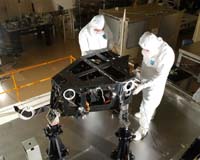 |
Houston, Texas (AFP) May 14, 2009 Spacewalking astronauts upgraded the Hubble telescope for the first time in seven years on Thursday, equipping the 19-year-old stargazer with a powerful new camera and science computer. The outing by John Grunsfeld and Drew Feustel, members of the seven-strong space shuttle Atlantis crew, marked the first of five daily spacewalks by the astronauts. The refurbishments are intended to extend observations with the iconic science instrument by at least five years, while equipping Hubble to search for the most distant star systems, probe the mysteries of dark matter and dark energy as well as study the formation of planets around other stars. The ambitious agenda of upgrades includes a second new science instrument, new batteries and gyroscopes, repairs to a pair of older science instruments with internal electronics failures and protective external shielding. "It's a great Hubble day," exclaimed Grunsfeld as he prepared to lead Thursday's spacewalk. Atlantis and its crew rendezvoused with Hubble Wednesday and hoisted the 13.2 meter telescope aboard using the shuttle's robot arm. Thursday's spacewalk paired Grunsfeld, a 50-year-astronomer who is visiting Hubble for the third time, with Feustel, a 43-year-old geologist on his first space mission. Robot arm operator Megan McArthur worked closely with the spacewalkers, moving them around the observatory on the tip of the mechanical limb. The team work paid off as the spacewalkers struggled at times to replace the telescope's Wide Field and Planetary Camera-2, a 16-year-old imager, with the new Wide Field Camera-3, a more versatile and capable instrument. The new camera, observing in ultraviolet and infrared spectrums as well as visible light, will peer deep onto the cosmic frontier in search of the earliest star systems as well as study the planets in the solar system. The new camera is to be joined during Saturday's spacewalk by the Cosmic Origins Spectrograph, an instrument developed to study the grand scale structure of the universe, including the star-driven chemical evolution that produced carbon and the other elements necessary for life. The older camera was stubborn about making way for its replacement. Grunsfeld and Fuestel reached for an assortment of ratchet tools to remove two bolts that secured the 16-year-old imager inside the telescope, throwing them about 30 minutes behind their timeline. As Grunsfeld reached into a tool bag for one of the ratchets, a rivet floated out. The veteran spacewalker reacted quickly by reaching out and grabbing the fastener before it could float away becoming yet another piece of space debris. The spacewalkers also worked with caution to avoid disturbing a dusting of a white material spotted near the shuttle's airlock on Wednesday. NASA feared the material might float free and contaminate the telescope's optics. "I see a small amount of what looks like dust, but it's pretty minor," Fuestel assured Mission Control. The installation of a new science computer proved to be a much easier task. The Science Instrument Command and Data Handling System experienced an electrical problem in late September. The setback prompted NASA to postpone plans to launch the Hubble mission in October so engineers could prepare a replacement. The computer prepares each of the telescope's science instruments for astronomical observations and formats the findings for transmission to Earth. "Great work," Mission Control told the spacewalkers as they raced through the task in 90 minutes. The third task on the first spacewalk was the installation of a new docking system. Although NASA has no plans for a future shuttle visit to Hubble, the new docking device would allow a robotic spacecraft with a propulsion module to latch onto the observatory. When Hubble is no longer able to conduct observations, NASA plans to steer the space telescope into the Pacific Ocean rather than allowing it to plunge back to Earth uncontrolled, potentially endangering a populated area. "Nice work," said Mission Control. Share This Article With Planet Earth
Related Links Space Telescope News and Technology at Skynightly.com
 Spacewalkers install new Hubble camera
Spacewalkers install new Hubble cameraHouston, Texas (AFP) May 14, 2009 Spacewalking astronauts equipped the Hubble Space Telescope with the first of two new science instruments Thursday, launching the first overhaul of the 19-year-old observatory in seven years. John Grunsfeld and Drew Feustel floated from the airlock of the shuttle Atlantis at 8:52 am (1252 GMT) to begin a spacewalk expected to span six to seven hours with a burst of enthusiasm. ... read more |
|
| The content herein, unless otherwise known to be public domain, are Copyright 1995-2009 - SpaceDaily. AFP and UPI Wire Stories are copyright Agence France-Presse and United Press International. ESA Portal Reports are copyright European Space Agency. All NASA sourced material is public domain. Additional copyrights may apply in whole or part to other bona fide parties. Advertising does not imply endorsement,agreement or approval of any opinions, statements or information provided by SpaceDaily on any Web page published or hosted by SpaceDaily. Privacy Statement |